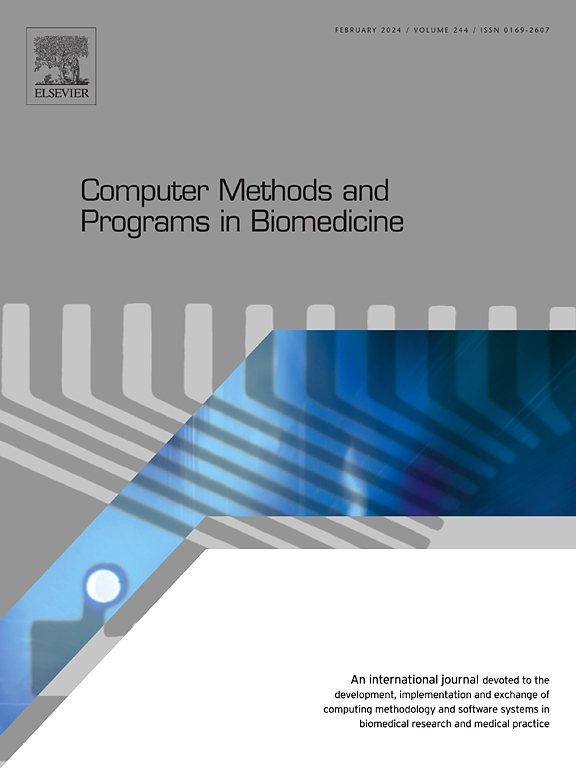TD-STrans:基于稀疏变换的三域稀疏视图CT重建。
IF 4.9
2区 医学
Q1 COMPUTER SCIENCE, INTERDISCIPLINARY APPLICATIONS
引用次数: 0
摘要
背景与目的:稀疏视图计算机断层扫描(CT)在医学诊断中加快了扫描速度,减少了辐射暴露。然而,当投影视图严重欠采样时,由于缺乏高频信息,基于深度学习的重建方法往往会导致重建图像过度平滑。为了解决这一问题,我们将频域信息引入到流行的投影图像域重建中,提出了一种基于稀疏变换(TD-STrans)的三域稀疏视图CT重建模型。方法:TD-STrans集成了三个基本模块:投影恢复模块完成稀疏视图投影,傅里叶域填充模块通过填充缺失的高频细节来减轻伪影和过度平滑;图像细化模块进一步增强和保留图像细节。设计了多域联合损失函数,同时提高了投影域、图像域和频域的重建质量,进一步提高了图像细节的保存性。结果:在淋巴结数据集上的模拟实验和在核桃数据集上的真实实验结果一致地证明了TD-STrans在去除伪影、抑制过度平滑和保持结构保真度方面的有效性。结论:TD-STrans的重建结果表明,多域稀疏变换可以缓解因缩图而造成的过度平滑和细节损失,为超稀疏视图CT成像提供了一种新的解决方案。本文章由计算机程序翻译,如有差异,请以英文原文为准。
TD-STrans: Tri-domain sparse-view CT reconstruction based on sparse transformer
Background and objective
Sparse-view computed tomography (CT) speeds up scanning and reduces radiation exposure in medical diagnosis. However, when the projection views are severely under-sampled, deep learning-based reconstruction methods often suffer from over-smoothing of the reconstructed images due to the lack of high-frequency information. To address this issue, we introduce frequency domain information into the popular projection-image domain reconstruction, proposing a Tri-Domain sparse-view CT reconstruction model based on Sparse Transformer (TD-STrans).
Methods
TD-STrans integrates three essential modules: the projection recovery module completes the sparse-view projection, the Fourier domain filling module mitigates artifacts and over-smoothing by filling in missing high-frequency details; the image refinement module further enhances and preserves image details. Additionally, a multi-domain joint loss function is designed to simultaneously enhance the reconstruction quality in the projection domain, image domain, and frequency domain, thereby further improving the preservation of image details.
Results
The results of simulation experiments on the lymph node dataset and real experiments on the walnut dataset consistently demonstrate the effectiveness of TD-STrans in artifact removal, suppression of over-smoothing, and preservation of structural fidelity.
Conclusion
The reconstruction results of TD-STrans indicate that sparse transformer across multiple domains can alleviate over-smoothing and detail loss caused by reduced views, offering a novel solution for ultra-sparse-view CT imaging.
求助全文
通过发布文献求助,成功后即可免费获取论文全文。
去求助
来源期刊

Computer methods and programs in biomedicine
工程技术-工程:生物医学
CiteScore
12.30
自引率
6.60%
发文量
601
审稿时长
135 days
期刊介绍:
To encourage the development of formal computing methods, and their application in biomedical research and medical practice, by illustration of fundamental principles in biomedical informatics research; to stimulate basic research into application software design; to report the state of research of biomedical information processing projects; to report new computer methodologies applied in biomedical areas; the eventual distribution of demonstrable software to avoid duplication of effort; to provide a forum for discussion and improvement of existing software; to optimize contact between national organizations and regional user groups by promoting an international exchange of information on formal methods, standards and software in biomedicine.
Computer Methods and Programs in Biomedicine covers computing methodology and software systems derived from computing science for implementation in all aspects of biomedical research and medical practice. It is designed to serve: biochemists; biologists; geneticists; immunologists; neuroscientists; pharmacologists; toxicologists; clinicians; epidemiologists; psychiatrists; psychologists; cardiologists; chemists; (radio)physicists; computer scientists; programmers and systems analysts; biomedical, clinical, electrical and other engineers; teachers of medical informatics and users of educational software.
 求助内容:
求助内容: 应助结果提醒方式:
应助结果提醒方式:


